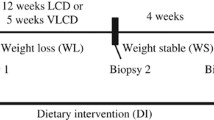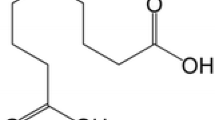Abstract
Obesity is considered as an inflammatory disease, in which free radical-induced oxidative stress and excessive intake of macronutrients exacerbate their symptoms. In this context, we assessed in rats the possible preventive effect of the supplementation with an antioxidant molecule, ascorbic acid, in order to reduce the adiposity induced by the intake of a high-fat diet. For this purpose, during 56 days, three groups of male Wistar rats were fed on: a) standard pelleted diet, b) Cafeteria diet, c) ascorbate-supplemented (750 mg/kg of body weight) Cafeteria diet. At the end of the experimental period, microarray analysis was used to identify genes transcriptionally induced or repressed by both experimental dietary models (Cafeteria diet supplemented or not with ascorbic acid) in subcutaneous adipose tissue. Dietary ascorbic acid was able to protect against high fat diet effects, reducing the increase of body weight, total body fat and enlargement of different adipose depots induced by the Cafeteria diet without affecting food intake. An association analysis accurately and differentially allowed the detection of gene expression changes related with adiposity and insulin resistance. The genes that more strongly correlated with body fat and HOMA insulin resistance index were involved in adipocyte differentiation, lipid and glucocorticoid metabolism, cell cycle regulation, as well as in several insulin-induced processes. Some other transcripts are regulated by the vitamin C-mediated reduction of adiposity, such as genes that participate in glucocorticoid metabolism, adipogenesis, pentose phosphate pathway, or tricarboxylic acid cycle. This strategy was able to link variations in adipose tissue gene expression with markers of diet-induced obesity in rats, such as insulin resistance and body fat content.
Resumen
La obesidad está considerada como una enfermedad inflamatoria, en la que el estrés oxidativo, inducido por los radicales libres, y la excesiva ingesta de macronutrientes incrementan sus síntomas. En este trabajo se estudia el posible efecto preventivo de la suplementación con la molécula antioxidante ácido ascórbico, para reducir la adiposidad inducida por la ingesta de una dieta rica en grasas en rata. Para este propósito, tres grupos de ratas macho de estirpe Wistar se alimentaron durante 56 días con: a) dieta estándar, b) dieta de cafetería, c) dieta de cafetería suplementada con ácido ascórbico (750 mg/kg de peso corporal). Al final del período experimental, se aplicó un análisis por microarray en el tejido adiposo subcutáneo para identificar los genes inducidos o reprimidos por ambos modelos dietéticos experimentales. El ácido ascórbico pudo proteger contra los efectos proadipogénicos de la dieta, previniendo del aumento en el peso corporal, del contenido total de grasa corporal y del peso de los diversos depósitos adiposos inducidos por la dieta de cafetería. Un análisis de asociación permitió además la detección de los cambios en la expresión de los genes más relacionados con la resistencia a insulina y la adiposidad. Los genes que correlacionaron más fuertemente con el porcentaje de grasa corporal y con el índice HOMA están implicados en la diferenciación adipocitaria, el metabolismo de lípidos y de glucocorticoides y la regulación del ciclo celular, así como en varios procesos regulados por la insulina. Otros genes que se mostraron relacionados con la reducción de la adiposidad debida al ácido ascórbico participan en el metabolismo de los glucocorticoides, la adipogénesis, la vía de las pentosas fosfato o el ciclo de los ácidos tricarboxílicos. En suma, la estrategia utilizada permite identificar variaciones en la expresión diferencial de genes del tejido adiposo blanco y asociarlos con marcadores de obesidad inducida por la dieta en ratas tales como la resistencia a la insulina y el porcentaje de grasa corporal.
Similar content being viewed by others
References
Abdel-Wahab, Y.H., O’Harte, F.P., Mooney, M.H., Barnett, C.R., and Flatt, P.R. (2002): Metabolism, 51, 514–517.
Baker, P.R., Cramer, S.D., Kennedy, M., Assimos, D.G., and Holmes, R.P. (2004): Am. J. Physiol. Cell Physiol., 287, C1359–1365.
Bluher, M., Patti, M.E., Gesta, S., Kahn, B.B., and Kahn, C.R. (2004): J. Biol. Chem., 279, 31891–31901.
Bolstad, B.M., Irizarry, R.A., Astrand, M., and Speed, T.P. (2003): Bioinformatics, 19, 185–193.
Campion, J. and Martínez, J.A. (2004): Horm. Metab. Res., 36, 485–491.
Campion, J., Milagro, F.I., and Martínez, J.A. (2004): Nutr. Rev., 62, 321–330.
Dandona, P., Aljada, A., Chaudhuri, A., and Mohanty, P. (2004): Rev. Endocr. Metab. Disord., 5, 189–197.
Davie, S.J., Gould, B.J., and Yudkin, J.S. (1992): Diabetes, 41, 167–173.
Doulas, N.L., Constantopoulos, A., and Litsios, B. (1987): J. Nutr., 117, 1108–1114.
Draganov, D.I., Stetson, P.L., Watson, C.E., Billecke, S.S., and La Du, B.N. (2000): J. Biol. Chem., 275, 33435–33442.
Duarte, T.L. and Lunec, J. (2005): Free Radic. Res., 39, 671–686.
Gredilla, R. and Barja, G. (2005): Endocrinology, 146, 3713–3717.
Jones, J.M. and Gould, S.J. (2000): Biochem. Biophys. Res. Commun., 275, 233–240.
Kim, K.N., Pie, J.E., Park, J.H., Park, Y.H., Kim, H.W., and Kim, M.K. (2006): J. Nutr. Biochem., 17, 454–462.
Kim, S., Sohn, I., Ahn, J.I., Lee, K.H., and Lee, Y.S. (2004): Gene, 340, 99–109.
Kume, E., Aruga, C., Ishizuka, Y., Takahashi, K., Miwa, S., Itoh, M., Fujimura, H., Toriumi, W., Kitamura, K., and Doi, K. (2005): Exp. Toxicol. Pathol., 56, 235–244.
Lamas, O., Martínez, J.A., and Marti, A. (2003): J. Physiol. Biochem., 59, 183–191.
Li, C. and Wong, W.H. (2003): In “The analysis of gene expression data: methods and software”, (Parmigiani, G. et al., eds.) Springer, New York, pp. 120–141.
López, I.P., Marti, A., Milagro, F.I., Zulet, M., Moreno-Aliaga, M.J., Martínez, J.A., and De Miguel, C. (2003): Obes. Res., 11, 188–194.
López, I.P., Milagro, F.I., Marti, A., Moreno-Aliaga, M.J., Martínez, J.A., and De Miguel, C. (2005): Mol. Cell. Biochem., 275, 109–115.
Martínez, J.A. (2000): Proc. Nutr. Soc., 59, 337–345.
Milagro, F.I., Campión, J., and Martínez, J.A. (2006): Obesity, 14, 1118–1123.
Moreno-Aliaga, M.J., Campión, J., Milagro, F.I., Berjón, A., and Martínez, J.A. (2005): Adipocytes, 1, 1–9.
Mutlu-Turkoglu, U., Oztezcan, S., Telci, A., Orhan, Y., Aykac-Toker, G., Sivas, A., and Uysal, M. (2003): Clin. Exp. Med., 2, 171–174.
Nadler, S.T., Stoehr, J.P., Schueler, K.L., Tanimoto, G., Yandell, B.S., and Attie, A.D. (2000): Proc. Natl. Acad. Sci. U. S. A., 97, 11371–11376.
Pérez-Echarri, N., Pérez-Matute, P., Martínez, J.A., Marti, A., and Moreno-Aliaga, M.J. (2005): J. Physiol. Biochem., 61, 333–342.
Pintauro, S.J., and Bergan, J.G. (1982): J. Nutr., 112, 584–591.
Recinos, A., 3rd, Carr, B.K., Bartos, D.B., Boldogh, I., Carmical, J.R., Belalcazar, L.M., and Brasier, A.R. (2004): Physiol. Genomics., 19, 131–142.
Reddy, S., Hama, S., Grijalva, V., Hassan, K., Mottahedeh, R., Hough, G., Wadleigh, D.J., Navab, M., and Fogelman, A.M. (2001): J. Biol. Chem., 276, 17030–17035.
Ruhe, R.C., and McDonald, R.B. (2001): J. Am. Coll. Nutr., 20, 363S-369S.
Sailaja, J.B., Balasubramaiyan, V., and Nalini, N. (2000): J. Biol. Chem., 275, 28246–28253.
Sailaja, J.B., Balasubramaniyan, V., and Nalini, N. (2004): Pharmazie, 59, 475–479.
Sato, J., O’Brien, T., Katusic, Z.S., Fu, A., Nygren, J., Singh, R., and Nair, K.S. (2002): Atherosclerosis, 161, 327–333.
Sparks, L.M., Xie, H., Koza, R.A., Mynatt, R., Hulver, M.W., Bray, G.A., and Smith, S.R. (2005): Diabetes, 54, 1926–1933.
Van Schothorst, E.M., Franssen-van Hal, N., Schaap, M.M., Pennings, J., Hoebee, B., and Keijer, J. (2005): Obes. Res., 13, 1031–1041.
Viguerie, N., Poitou, C., Cancello, R., Stich, V., Clement, K., and Langin, D. (2005): Biochimie, 87, 117–123.
Yu, D.H., Lee, K.H., Lee, J.Y., Kim, S., Shin, D.M., Kim, J.H., Lee, Y.S., Oh, S.K., Moon, S.Y., and Lee, S.H. (2004): J. Neurosci. Res., 78, 29–37.
Author information
Authors and Affiliations
Corresponding author
Rights and permissions
About this article
Cite this article
Campión, J., Milagro, F.I., Fernández, D. et al. Diferential gene expression and adiposity reduction induced by ascorbic acid supplementation in a cafeteria model of obesity. J. Physiol. Biochem. 62, 71–80 (2006). https://doi.org/10.1007/BF03174068
Received:
Issue Date:
DOI: https://doi.org/10.1007/BF03174068




